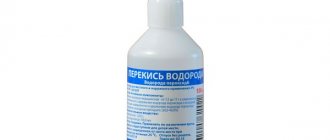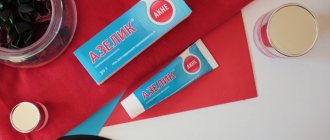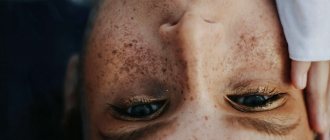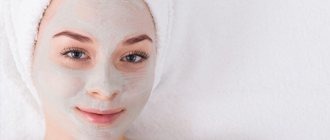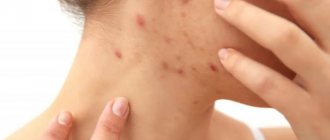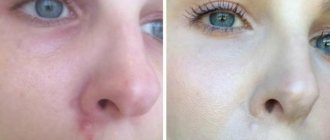“When you cure your acne, then you will do makeup!” often heard by people with problem skin.
I don't agree with this. If you have healthy skin and an even complexion, foundation is not really needed, except for evening makeup or photo-video shooting.
In everyday life, it is those with problem skin who need concealers more than others.
However, walking from morning to evening with a thick foundation on your face is also not the best idea; this approach can aggravate acne. Why? And I described in detail how to find the golden mean in the book “55 Mistakes in Facial Care.”
And in this article I have collected for you tips from makeup artist Elena Igradi from an interview for my channel “Cosmetologist.net”
- What can't be hidden with makeup?
- Makeup mistakes with acne
- How to disguise a subcutaneous pimple
- Pimple crust - what to do
- How to hide acne spots
- How to choose foundation for problem skin
Makeup mistakes with acne
There is no need to dry out the skin and acne. It is impossible to remove or disguise a dry crust; makeup will only emphasize it.
Do not squeeze pimples - blood-red crusts will only complicate the task of camouflage.
The relief can only be removed in Photoshop @emeraldxbeauty
How to disguise a subcutaneous pimple
1. A large subcutaneous pimple is usually a little purple, and in such a situation it is very important not to use the green concealer that they like to sell us just for such a case.
In fact, it works so-so with purple. In this case, a gray-yellow corrector is more suitable - it can tone down the redness and work with purple.
2. The amount of corrector should be vanishingly small. First you need to apply the corrector, and then the foundation. It is best to apply the foundation using patting movements so as not to smear the concealer layer.
3. Another important point is that during the day, the newly appeared subcutaneous pimple will grow and increase in volume. Therefore, subcutaneous camouflage should be approached like clothing for a child to grow into.
Do not use dry concealer - it will crack immediately. The camouflage of a subcutaneous pimple should be elastic.
Concealers such as NARS Soft Matte Complete Concealer and Make up for Ever Full Cover Concealer are suitable.
4. Don't rely too much on makeup fixers. Fixers are not makeup armor. They only allow makeup to last a little longer in ideal conditions.
That is, in essence, these are means for a spherical horse in a vacuum - they only work if you help them. You can apply a little powder to set your makeup. Just a little bit for grip.
Problem skin and makeup
Hello, dear beauticians! Walking through various beauty portals, I notice one sad thing: very pretty girls buy very expensive things and do bad makeup with them. Unfortunately, they often do not pay due attention to the preliminary tinting of the face, which is why even the most beautiful products (eyeshadow, blush) cannot be seen due to the fact that you are distracted by spotty skin under a merciless macro. Plus, shading on poorly prepared skin is generally difficult, which means that the product will appear in the photo to be of poor quality, dry, and sometimes even colorless or, conversely, appearing in spots. Is this what they tried for? A painting needs a canvas, but how often have you seen spotted canvases?
In this post I would like to share my observations and experience about the difficult task of bringing problematic skin into a divine appearance with the help of preparatory procedures, foundations and techniques for applying them. I don’t have a diploma as a makeup artist, but believe me, with my age-related problem skin, I know how to make it look (without Photoshop) so that it looks at least a little like the skin of a model with her back to the window during sunset.
Please cut below!
Step 1. Scrub
A little scrub before makeup (the secret, among other things, of Christie Brinkley's radiant face) helps remove dead cells, the face will come to life, brighten, and the foundation will lie smoother. Dead cells float up on the skin all the time, and not “2 times a week,” as it says on the scrub packaging, so go ahead, exfoliate a little every day. The best time to scrub is, of course, in the morning, before putting on makeup for work. We rub the face very lightly, barely touching the skin with our fingertips, we remove only the stratum corneum, not the muscles. Otherwise, the result will not be better, the skin will only stretch pointlessly and may disturb the blood vessels.
Step 2. Mask
If you have a mask with a noticeable pigment-constricting effect, this is the time to apply it to problem areas (T-zone). For the rest of your face, it would be good to apply a mask with a moisturizing and repulping effect.
Step 3. Catch the water before it runs away.
Wash off the mask with warm, then cool water. Dry your face with a towel only until it is “so that water does not spill on the floor” and immediately, without waiting for it to dry completely, apply a moisturizer or serum rich in water-retaining ingredients
(hyaluronic acid, glycerin, algae, etc.) This is the only way you can seal water in the skin so that your face remains smooth and “full” for a long time.
Step 4. Silicone.
I used to use silicone wrinkle fillers and products like Idealist
so that the silicone fills the “minus tissue” (all sorts of holes). Now I do this, but less often, because... I don't always like the feel of silicone. In addition, a well-moisturized face (step 3) does not need this so much. But you can try it and see if you like this stage. Perhaps this stage will be useful for wrinkles.
Step 5. Stop and think.
Many (including myself) note the benefits of pauses between different stages of makeup: Moisture. cream - pause. Foundation - pause. Concealer - pause. By allowing the previous product to absorb well and settle, we achieve a more even effect of the product lying on the skin.
Step 6. Foundation.
I think most of you use the “cream” texture in foundation. Trust me: you definitely need a beauty blender
!
I can't imagine myself without this sponge! The special design allows you to apply the foundation wetly, increasing the moisture and elasticity of the skin, and the porosity of the beautyblender
allows you to fill even the most secluded pores with cream, thus creating the most even surface. We apply foundation by rolling, but mainly driving in a sponge.
Step 7. Correctors, concealers.
I personally apply correctors after foundation, although many people do the opposite. For a more natural look, I can pat it on top with a sponge so that the foundation blends better with the concealer. Use thin, delicate textures of concealers, such as those from Armani
.
But spot imperfections are best covered with a thick corrector on a small brush, such as Kryolan
.
And in general, don’t try to cover your face to death: new generation foundation creams have a “smart” light-scattering effect, which is why there is no longer any need to apply too thick pigment, which will look like makeup.
Step 8. Powder.
In general, if the foundation holds oil well, you can skip powdering, or powder only the T-zone. The fact is that powder quickly draws moisture from the skin, and the face can take on the effect of makeup, and wrinkles will intensify. If you are going to apply dry blush, you need powder so that the blush does not stain into the foundation. Particularly stubborn imperfections can be covered once again with concealer and powdered again. I'm not a fan of mineral powders; they look rough on me. My favorite powder is La Mer loose powder
.
Chanel Poudre Cristalline
also has a rather attractive effect .
Step 9. And water again!
A couple of minutes after your makeup is completely ready (eyes, lips and everything), spray your face with a moisturizing, fixing or moisturizing-fixing product. Fine spray only, cloud. After this, do not touch your face, do not slam it, just leave it to dry. This is an amazing technique that will instantly remove the “powdered” effect and seal your makeup under a film of freshness, and if you’re lucky, also with all sorts of antioxidants! I successfully use MAC Brume Fixante
with the aroma of cucumber, but your favorite tonic (only without astringents) will do.
You see, just two hours - and you can go to work! Well, when it all becomes a habit, it will be much faster, and you won’t have to make a mask every time. The main thing I learned for myself is more moisture, a sponge and only the best foundations; we, the sad ones, cannot skimp on them. Better a hole in tights than plaster in holes!
BLUSH.
The issue of blush deserves special attention. Blush can be dry or creamy. Both of them can become your number 1 enemy! Dry blush
they look very good if you apply them to a face prepared according to the Ninfeo method, on top of foundation and the obligatory powder, with a very soft brush, constantly knocking off the excess and blending gradually, getting the color in several passes, and not in one.
Cream blush
is a completely different story for uneven skin. We simply cannot apply them with our hands on top of the foundation, because... all your makeup will be destroyed. Therefore, I do this: I put cream blush on a beauty blender, having first mixed it on my hand with a drop of foundation, and rub the blush onto my cheekbones. This gives a magical effect: a complete fusion of yin and yang, fresh ruddy skin, the blush simply sits as if it were your own, and it’s even a pity to put on powder!
A couple of tips for photographing a swago's face with makeup
- Face the light
, not sideways.
Side light will highlight everything that is not needed. — Use flash
.
Terry Richardson is the most popular celebrity photographer not because of his angelic disposition, but because of the legendary perfect skin that he achieves with the help of a giant flash. — The white sheet
under the face is a little trick; when you take pictures with a flash, it additionally scatters the light in a different direction!
Holding this sheet of paper with one hand, trying to click the camera in the desired angle with the other hand and at the same time smiling relaxedly is as easy as shelling pears! (not!)
- Study
color types
and do not use makeup products that do not match your coloring. The main benefit of color typing is that correctly selected shades visually mask and fade imperfections, rather than highlighting them. For example, red hair color is contraindicated for me.
I hope you found this post helpful. I invite you to discuss. How do you even out your skin? Do you know any interesting videos on this topic? What products are your must-haves?
Photo: all mine, except for the products, only the powder is also mine... I hope I wrote it clearly
Increase
Pimple crust - what to do
Do not dry the crust before applying makeup. It is better to moisten the crust as much as possible so that it becomes soggy.
When you have soaked the crust, you can try to carefully remove it with a cotton swab. But here, as in the case of burrs, there is a limit that cannot be crossed. Otherwise, a wound will appear that will be impossible to disguise.
It is better to remove the remaining crust from makeup using a cotton swab dipped in micellar water. Remains of micellar water can be removed with another clean, damp end of the same stick.
A crust on the face will look more natural than something that looks like a croissant - a wound covered with tone, from which ichor appears
